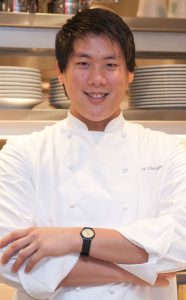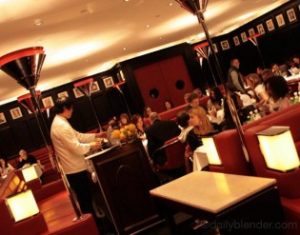 The luxurious ambiance of The Lambs Club in midtown Manhattan is captivating for a first-time guest. The relatively modest entrance on West 44th hides the glamour within, an elegant space reminiscent of the city’s glory days with an interior of art deco sconces along wood-paneled walls, an illuminated four-seat bar manned by gentlemen in white suits, and a dining room of red leather guarded by an original painting of Lambs Club members – a star-studded roster from the beginning of stage and screen including everyone from Chaplin to Rodgers & Hammerstein.
The luxurious ambiance of The Lambs Club in midtown Manhattan is captivating for a first-time guest. The relatively modest entrance on West 44th hides the glamour within, an elegant space reminiscent of the city’s glory days with an interior of art deco sconces along wood-paneled walls, an illuminated four-seat bar manned by gentlemen in white suits, and a dining room of red leather guarded by an original painting of Lambs Club members – a star-studded roster from the beginning of stage and screen including everyone from Chaplin to Rodgers & Hammerstein.
Since early 2012, 27-year-old Eric Kim Haugen has led the line as Executive Chef at The Lambs Club, presenting classic, clean dishes like chicken fricassée and Delmonico steak to the generally theater-going crowd. After graduating from Johnson and Wales, Haugen ventured out West, apprenticing at Thomas Keller’s The French Laundry before moving on to cook at L’Epicureo, Cortez, and One Market in California’s Bay Area. Returning to the East Coast, he positioned himself at The Ocean House in Rhode Island, where Forbes and Food & Wine both took notice of his talent. Moving to New York earlier this year, Haugen took the stage at The Lambs Club under chef Geoffrey Zakarian and was named to Zagat’s “30 Under 30” list only a few months of his arrival.
I was introduced to chef Haugen, as well as the marvelous Lambs Club, earlier this fall as part of the Food Network New York City Wine and Food Festival, and was impressed by it all. An interview was certainly necessary.
Q: How has the post-Hurricane-Sandy recovery been?
A: The restaurant is doing very well. We are fortunate to be centrally located in Manhattan. Our efforts were primarily during the storm and the couple of days after. We were determined to continue to feed the hotel guests and those who were in the area looking for a great meal; I think we accomplished this certainly.
 Q: One of my favorite sessions at the NYCWFF was certainly Hot Cocktails with you and chef/owner Geoffrey Zakarian. Do you take the drinks at the bar into consideration when determining new menu items – or is it the other way around?
Q: One of my favorite sessions at the NYCWFF was certainly Hot Cocktails with you and chef/owner Geoffrey Zakarian. Do you take the drinks at the bar into consideration when determining new menu items – or is it the other way around?
A: We don’t necessarily see cocktails and food as pairings first, per se. Both however, are seasonally driven and will often times have complementary products being used in their production. For instance, we are seeing citrus all throughout the cocktail menu currently. This is also the case for the dining room menu. We take the beverage program very seriously here, and I love that. Everyone tastes the cocktails before going on the menu, and I think what really makes them so unique and finessed is the contribution and collaboration of the bartenders. It’s truly world class and the staff really owns the creations. That being said, every cocktail would be delicious and educational paired with food – our approach is just generally wine first with pairings, due to the nature of the dining room.
The food has a very light approach to it. You won’t find heavy or over-assertive seasonings, and rarely will anything be spicy or offensive. Which keeps the wine program in mind, more so than cocktails, I suppose. If I’m upstairs for a snack however, I will always have a cocktail knowing I will not be disappointed. My favorite is the St. Jacques, created by Jacques, one of our bartenders. It combines bourbon, cognac, Chartreuse and Fernet. Unreal.
Q: I read that you and chef Zakarian had developed a friendship before you joined the staff this year. We’ve all seen him on TV, but what’s he like to work with in the kitchen?
A: Geoffrey and I met at my last position. We have kept in touch ever since. I don’t ever see him as a “TV” chef, and it certainly isn’t what drew me to work under him. What I appreciate most about him is that if I ask him to schedule time for me to taste him on food or to try dishes together, he always finds time and it’s as much as I need, even if it’s between obligations. We will sit down over espresso and just talk about food, and our thoughts and ideas, and maybe a little golf every now and then. His approach is very simple in terms of the finished product and the message, but the work and process of completing those basic ideas is much deeper. He is about extracting all of the desirable qualities of dishes, and trying to find a way to make all of those details perfect in hopes of having an amazing result. The other day for instance, we spent a good amount of time tasting a cheeseburger. We sat there and just looked at it, tasted it, and talked about it (it gets served for brunch, lunch, and in our lounge).
Many restaurants serve cheeseburgers, but many don’t pay attention to the details. For us, it’s about the texture of a potato bun vs. a brioche bun, or the benefits of using a confit tomato versus a raw tomato with no seasoning, or slicing thirty pounds of onions to extract one pint of caramelized, concentrated syrup. These details are what the guests don’t necessarily see, but they hopefully leave amazed. I think this idea is evident throughout his brand in everything, from the kitchen to the dining room. He has been an amazing mentor and educator, and has shown me nothing but respect and generosity. Moving to New York and working for him was the best decision I have ever made, and I hope the relationship stays for many years.
Q: You were on hand for the taping of Iron Chef America as his sous chef. How was that experience? Is there any kind of pre-show, random ingredient practice?
A: The experience itself was very real for me; I grew up watching the Japanese version so to finally have the opportunity to compete was rewarding. We practice by simply preparing ourselves for whatever comes at us. The easy part for our team is that we all have similar approaches to food, so we see eye to eye. If the secret ingredient was going to be skate for instance, would make Grenobloise sauce, capers-lemon-brown butter, and serve it with cauliflower in many fashions simply because I know that’s what Geoffrey Zakarian would do. Some of the cuisine that chefs present in one hour is incredible, and the success rate in terms of quality a completion in one hour continues to amaze me given the time constraints. It’s a push, and yes, it’s really only 60 minutes.
Q: Where do you look for inspiration on new dishes?
A: Inspiration comes from a lot of places. I read a lot of cookbooks, and am enamored in food blogs and the current events of the industry. Inspiration for me can come from something as simple as Jonathan Waxman’s untouchable roast chicken, to a shape I might see on the side of a building walking to work. I also have an amazing staff to lean on. We have a mole on our menu with duck and huckleberries. The recipe comes from one of our breakfast cooks, Fidel, and was passed down from his family and the generations of making the same mole. The internet has helped to progress this industry in so many ways, also. I use my social media to post real time photos of dishes and within minutes, I have replies or comments from friends and colleagues all over the states. Information is accessible more than it ever has been, which at the end of the day benefits the guest the most, and that’s the ultimate goal.
 Q: Do you have a signature dish or ingredient?
Q: Do you have a signature dish or ingredient?
A: We don’t have a signature dish per se, because we change our menu seasonally. We also don’t tend to revisit old ideas or dishes too much. This prevents our restaurant from discovering new ideas and new techniques. We want to evolve, not stay in the same place or go backwards. There are dishes which we could never remove from the menu because of the demand, such as the chicken paillard at lunch. Demand and signature dishes are very different.
Right now, we are fixated on Blis products; their maple, smoked trout roe, and solera elixirs are some of our favorites. It’s Fall right now, so we have started working with some cuts of meat which require long cooking times such as lamb neck, beef rib, and veal shoulder. Braising is one of the hardest techniques to master in my mind, because it requires so much attention through many steps and cooking mediums over a long period of time, in hopes of having a consistent final result.
Q: Where are you eating and drinking in NY when you’re out and about?
A: I like to cook with products from the market on my days off. In the summer I used to buy heirloom tomatoes and eat them like apples on the way home. We source from the Greenmarket four times per week, and I have brought that philosophy to my home as well. As far as restaurants are concerned, I really enjoy China Café for authentic Szechuan cooking. Like I mentioned before, I really enjoy Jonathan Waxman’s Barbuto. He was one of the original sous chefs at Chez Panisse in Berkeley, California. Having cooked in the Bay Area for a while, I can appreciate the products and the importance of sourcing the best products and simplicity. He really does it better than anyone else. The roast chicken is as delightful as anything I have ever eaten anywhere, and it’s just chicken.
Q: What are your long-term goals in the kitchen? A restaurant of your own? Cookbooks? More TV?
A: I don’t have too many long term goals right now simply because I am so content with what I am doing right now. I am about to complete my first year with Geoffrey and the Lambs Club and we have a very exciting 2013. I have learned a tremendous amount about this city and its diners, but also about myself and what I am capable of and what I need to improve upon. I’d eventually like to have a business, naturally, like a lot of cooks and chefs. I am honest enough with myself, though, to know that restaurants are challenging to not only operate day to day, but to connect each effort in hopes of developing a solid brand with a clear and concise message to the guests. If I decide I want to open a business one day, I will do it with longevity in mind. It’s about capturing the guest and having them fall in love with you, and in restaurants, often times you only get one chance. That’s what makes our jobs so dynamic, because we dedicate ourselves to bringing satisfaction to others through nourishment and genuine hospitality.
~Jennifer Heigl
*Photo credit: chef image – Marianne Rafter; restaurant & food photos – Jennifer Heigl/Daily Blender
